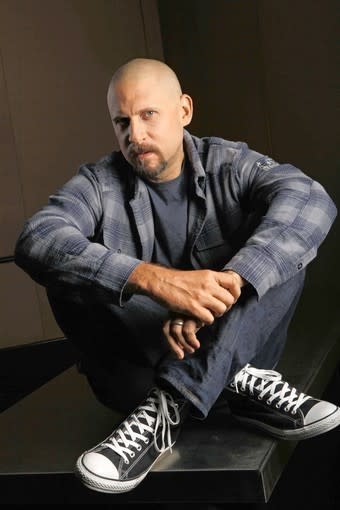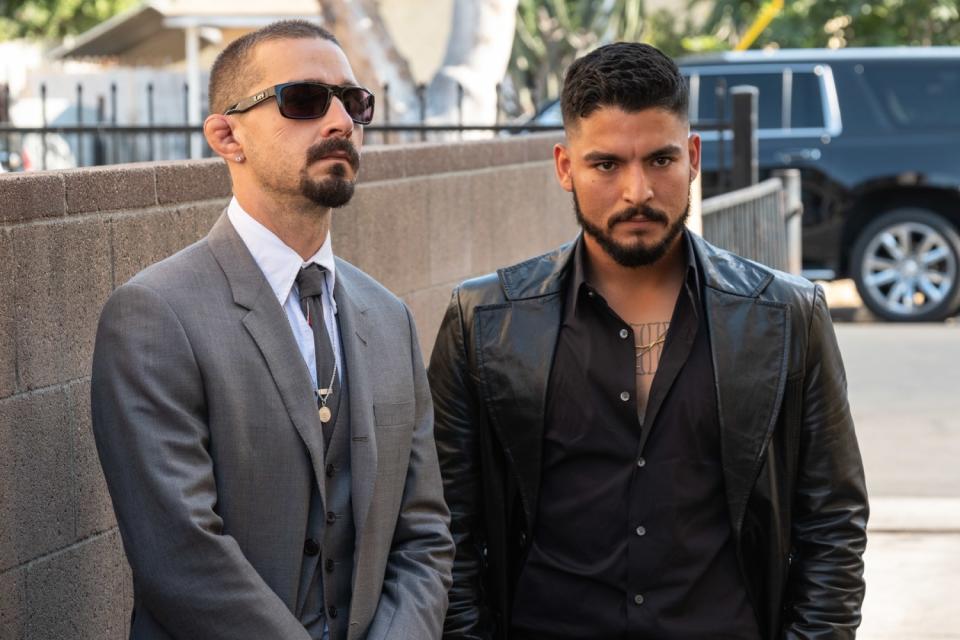Director denies he put Shia LaBeouf in 'brownface' but controversies linger

The trailer contains many of the markers of a modern Los Angeles gangster flick and box office hit: guns, lovely Latinas, thumping music and attractive dudes in the dopest cars riding around the flatlands of L.A. as they lay down the law of the streets.
Almost all the actors are brown-skinned Latinos, except for one. At the center of the clip is Shia LaBeouf — in dark-trim hair, black sunglasses and a barrio accent.
Is it “brownface”?
The question has elicited conflicted online responses and awkward-smiled emojis since the trailer's release and run-up to “The Tax Collector,” which opens Friday. In it, LaBeouf looks "Mexican," at least by stereotypical standards. He wears a goatee and sounds like a Latino guy from the ’hood. At one point he says, “Come on, foo’!,” certified barrio slang for "fool." LaBeouf, the sometimes troublemaking Hollywood star who won wide praise for last year's autobiographical drama "Honey Boy," appears to have taken on the persona of the L.A. cholo.
Amid the spark of this spring’s George Floyd protests, and the sweep of reparative action that has taken place in Hollywood and other branches of society — including apologies from Jimmy Kimmel and Jimmy Fallon for past blackface comedy routines and the removal of "30 Rock" episodes with blackface scenes — accusations of brownface rained down on "The Tax Collector."
The film’s director, David Ayer, quickly responded on Twitter. LaBeouf, said the filmmaker who often talks about growing up in South L.A., is not playing a Latino character but rather an Anglo steeped in Mexican American culture — "a Jewish dude playing a white character." Therefore, Ayer said, LaBeouf’s turn as the gangster enforcer “Creeper” couldn’t be brownface.
Case closed? Over the course of two interviews with The Times, during which the director sometimes switched between English and Spanish, Ayer described "The Tax Collector" as a family crime drama about love and loyalty. LaBeouf plays a supporting role to lead Bobby Soto as David, in a cast that is otherwise entirely Latino or Black.
“He’s a white guy playing a white guy. He’s not taking anyone’s work away,” said the director. Though it should be added that the film doesn't expressly establish the ethnic identity of LaBeouf's character.
“I get the complexities of the issues of historical representation in film and brownface. ... It’s also like ‘American Me,’ ‘Blood In Blood Out.’ It’s a ’hood culture thing.”
This argument brings up a rarely discussed topic in California culture: the presence of non-Latinos integrating in real life among ethnic Mexicans in the state's urban and rural barrios. When it comes to film and art, the debate prompts the question of who gets to adopt whose culture, especially in a period of intense cross-cultural scrutiny over cultural appropriation.
Ayer himself referred to films in a subset of American cinema that feature characters who are non-Latino but are presented as culturally integrated and accepted in Latino communities.
In 1993's “Blood In Blood Out,” for example, Damian Chapa plays Miklo, a half-Mexican, half-Anglo member of an Eastside gang who is sometimes mocked for not being fully Mexican. Chapa is part-Mexican himself. "Chicano is not a color," Chapa as Miklo says passionately in a key scene. "It's the way you think and the way you live."
Another memorable case is the 1981 Luis Valdez film “Zoot Suit," featuring characters like Tommy Roberts (Kelly Ward) and Alice Bloomfield (Tyne Daly), who speak Spanish and are trusted by Henry Reyna and his family.
Others pointed to the long history in U.S. filmmaking of non-Latinos playing ethnic Mexican characters — to positive effect or not. Charlton Heston wore dark eyebrows, a mustache and makeup to play Ramon Miguel "Mike" Vargas in Orson Welles’ 1958 classic “Touch of Evil,” and Lou Diamond Phillips, who is Filipino American, portrayed real-life Mexican American rocker Ritchie Valens in the 1987 Valdez-directed hit “La Bamba.”

From Boyle Heights to Pomona and even Japan, according to historians and social scientists, non-Latinos have long adopted Chicano dress, cultural customs and even the spoken accent associated with California barrio culture.
"You wouldn't even know that they weren't Chicano, but they were white guys who lived in East L.A. or South L.A. or Monterey Park or Montebello. I feel like there’s always a white guy hanging out," said Denise Sandoval, a professor in Chicana and Chicano Studies at Cal State Northridge. "I think it’s a style. It is like our patois, and these discussions are always happening when a machine like Hollywood or Disney uses our culture."

"The Tax Collector" uses Chicano culture, its critics say, in ways that employ violent stereotypes associated with cholos and the Mexican American mafia.
“My first impression was like, ‘Oh look, a cholo movie starring Shia LaBeouf,’ and technically that’s what it is,” said Lalo Alcaraz, the editorial cartoonist and satirist. “There’s no literal brownface, but it’s definitely cultural brownface.”
William A. Nericcio, a professor at San Diego State University and most recently co-author of “Talking #BrownTV: Latinas and Latinos on the Screen,” said he finished watching the trailer feeling “toxic.” “How many times does he put a gun in a person’s mouth in a two-minute period? That’s not to say that raza who work in gangs aren’t bad guys, but enough already.
"Enough of this mierda,” or crap, Nericcio said.
A line blurred
Ayer is not only the film's director, he wrote the screenplay — as he did for the Antoine Fuqua-directed "Training Day," which won Denzel Washington his second Oscar. He also co-wrote “The Fast and the Furious.” The 2001 street-car saga was initially set in New York, but Ayer recast it to the poly-ethnic streets of Los Angeles, and thus sparked one of the most successful multimedia franchises in history.
As a director, Ayer, 52, hit the box-office jackpot with the 2016 DC Comics hit “Suicide Squad.” In “The Tax Collector,” the director said he is returning to his favorite form, working intensely with actors and shooting in his kinetic back seat-view style. Another familiar trope in his oeuvre is the use of psychologically intense and often graphic violence.
Critics sometimes pan his work, but audiences usually lap it up.

As it turns out, the controversy he is facing is not unlike the questions that Ayer himself has faced over the course of his life for being "the only white boy" around people of color.
Though he holds back many of the details, Ayer said he’s always been around barrio culture. He moved to Los Angeles as a teenager, and fell into the life of the West Adams and South-Central sections of South L.A.
Jose “Conejo” Martín, the actor who plays the chief antagonist in “The Tax Collector,” met Ayer as a 9-year-old in the same neighborhood. Indeed, Martín's role reflects a real episode in his life: The actor explained that he was extradited to the United States from Mexico after years of being on the run from the law. As soon as he was released from prison in 2018, Ayer hired Martín to play a character that is similar to the actor’s actual life story. The film shot that summer.
“I’m from 22nd and Catalina, he’s from 24th and Budlong,” Martín said in an interview, citing the shorthand of street intersections in South Los Angeles. “We go back.”
If you grew up in the ’hood, you know that white boy!
Chelsea Rendon, actor
Ayer is an unlikely Hollywood success story. He served in the military and got his first break after working as an electrician at the home of a screenwriter. He also lived in a "small town outside Culiacán," in the Mexico state of Sinaloa, which he said gave him an understanding of transnational narco culture.
"I'm used to being the only white boy," Ayer said. "Con la gente que cuenta [with the people that count], I'm good. ... I've always kept this to myself. It's my private life."

LaBeouf was not made available to comment for this story, but it is well-known he grew up in Echo Park. At 34, he has collected his share of public controversies, sometimes tied to claims that he cites or repeats phrases without crediting sources, or getting a little too committed to his characters on set. Playing a bootlegger in the 2012 film "Lawless," LaBeouf reportedly drank excessive amounts of moonshine.
"He really wanted to get under the skin of it," director John Hillcoat told GQ magazine a few years later, while conceding, "He did take it too far."
And while preparing for "The Tax Collector," LaBeouf got his character’s name tattooed over his stomach, along with other tattoos, at Echo Park's Reservoir Tattoo Studio.
Shop owner Bryan Ramirez, also an Echo Park native, said LaBeouf walked in alone one day and asked to get something done. "He didn't seem like an actor at all."
LaBeouf now has an entire front torso set of tattoos that employ elements of barrio iconography, forever — all for a role that is technically secondary in nature.
"He’s got two portraits. He’s got some flowers going around to get a decorative frame going around his torso, and some letters that say CREEPER, and some Mickey [Mouse] hands pointing at each other underneath that," Ramirez said. "I think it's something deeper for him. We played at the same park, we even knew some of the same people that we grew up with, and to me that’s just being real, who he is, where he comes from."
Ramirez isn't alone in giving LaBeouf a break. Some of the online commentary, for instance, has switched around on the critics. Foos Gone Wild, the social-media phenomenon that celebrates cholo culture, declared “Shia is a foo'” on Instagram, leading to a cascade of approving, comical messages from other users.
Other cast members also defended Ayer’s cultural credentials, and pointed to his films for proof.
Chelsea Rendon (who made a splash for her role as a rebellious Boyle Heights activist in the Starz series “Vida”) stars as Lupe, a key member of the family in "The Tax Collector."
“I think it’s just a really great story, showing the gritty streets, and that’s what David does best, when you think of ‘Training Day’ and ‘Harsh Times’ and ‘End of Watch,’ they have this grittiness to them,” she said.
Soto, the film's star, agreed.
"In all these movies, [Ayer] included the Chicano culture, he did it in 'Suicide Squad,' where he had the first Latino superhero Jay Hernandez play the Diablo, he’s put brown people in front of the camera more than anyone," Soto said. "He’s Chicano inside, he’s raza 100,000 percent, it’s crazy," the actor said with a laugh, adding that he and LaBeouf recently opened a theater company in Soto's old Southside neighborhood.
Regarding the brownface controversy, Rendon said: “Shia plays a white boy who grew up around Mexicans, and if you grew up in the ’hood, you know that white boy! And that’s the funny thing, from seeing stuff on social media.”

Who will watch it?
Even though the film traffics in violent tropes we've seen again and again with Latino characters in Hollywood crime dramas, the core audience for "The Tax Collector" is arguably Mexican Americans, Mexican immigrants and those who interface daily with these groups anywhere they live. Guys who've been in the prison system, or know what it means to lose someone to violence. Or simply people who are aware of a layer in U.S. Latino society that is devoted to corporatized crime and are intrigued by movies about it.
On that point, "Tax Collector" could come with a trigger warning before screenings. For anyone who's experienced first-hand the loss of a loved one to the horrors of the binational drug war — which tends to occur for so many survivors away from the limelight — the film's graphic depictions of cartel violence and death culture could be difficult to watch.
Rosa Parra, a native of East Los Angeles and daughter of immigrants from Mexico, is a film writer and member of the Hollywood Critics Assn. She said she also initially felt “disappointed” in the depictions she saw in the run-up. “But then, as the trailer went on, it caught my interest.”
She also read that Ayer grew up in a similar environment, “so that kind of intrigued me,” Parra said. “So I said, ‘OK, I’ll have to watch this.'” Later, after seeing the film, Parra said she had “thoughts,” which she’d surely address in an upcoming review.
The Hollywood Reporter's David Rooney said the film is "well acted" but "predictable." Variety's Peter Debruge said of "newcomer" Soto, "you’ll understand what Ayer saw in the actor, who could easily go on to become a marquee name," but called the climactic battle "more inept than engaging." And Eric Kohn at IndieWire said of LaBeouf's character, "a baffling Chicano caricature who may as well be dropping 'ese' after every other word."
Notably, the film makes no direct mention or reference to Creeper’s background. LaBeouf’s character doesn’t refer to being “white” or non-Mexican at any point. When asked about the discrepancy, Ayer said he just didn’t think about it. “To me, it was so obvious and known and it didn't occur to me, in this new climate, with everyone trying to reverse-engineer your work for malice,” Ayer said. “I made this for the ’hood.”
But will the ’hood respond approvingly? At least for some tastemakers, those who cringe at excessive representations of some Latino stereotypes, a few harsh assessments are already in.
"This movie feels out of place, and I know they didn't shoot it this year, and it’s not their fault," said cartoonist Alcaraz. "My point is to show that the future is not going in that direction."
For the record:
12:13 PM, Aug. 06, 2020: An earlier version of this article said the series “Vida” is on FX. The show is on Starz.

 Yahoo Sports
Yahoo Sports 